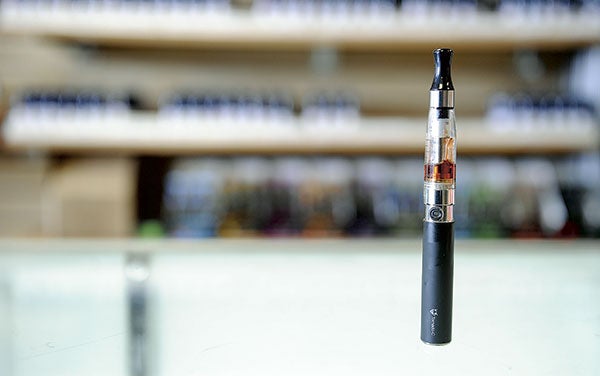Council takes step toward raising legal buying age of tobacco to 21; Aims to curb vaping in schools
Published 8:07 am Thursday, February 21, 2019

- An example of an e-cigarette offered at the Tobacco Store in Austin. Herald file photo
Seeking to curb the usage of tobacco in minors, the Austin City Council unanimously approved a draft ordinance Tuesday that, if adopted, would raise the legal age for individuals buying tobacco from 18 to 21 years.
The council may act on the ordinance at its next meeting.
During Tuesday night’s work session, the Austin Area Drug Task Force presented information regarding the growing concern surrounding e-cigarettes and vaping among students in the Austin Public Schools District. Austin Area Drug Task Force Coordinator Bonnie Rietz approached the City Council about changing the legal sales age from 18 to 21 in Austin.

Bonnie Rietz
“About 95 percent of those who are addicted to smoking started as teens,” Rietz said. “They cannot stop. By imposing an age limit, the numbers went down by 50 percent, and 70 percent of smokers support it. We’re looking at several cities across the state who are changing their legal age limit.”
Councilman Steve King said the task force had been working to curb the increase of vaping among younger students within the school districts in Mower County, particularly in Austin.
“They’ve been doing a lot of good work to limit the illegal use by young people,” King said. “There’s an epidemic of vaping in schools.”
Chris Weis, Mower County community health specialist, presented information to the council during its work session along with examples of marketing for the products. E-cigarettes and other products containing nicotine come in brightly-colored packaging. She has been traveling around the area visiting school districts and educating parents and teachers on e-cigarettes and vaping.
With the relatively new entrance of these devices into the market, many parents and staff members weren’t familiar with what the electronic devices looked like, hindering the chances of catching students with devices at school. Many of the e-cigarette devices resembled USBs, highlighters and even chargers.
“There’s no regulations on how these companies can market to kids,” Weis said. “One pod can contain the same amount of nicotine in a pack of cigarettes.”
For many on the council, the proposed ordinance may assist with curbing the number of underage minors vaping. They also acknowledged that vaping was still new, and it was hard to know the immediate effects vaping can have on health, such as addiction.
Officials also looked at possibly reaching out to Palmer Bus Services in helping identify devices that are being used while students are transported to and from school.
Possible ways to help identify vaping would be through the scent of flavorings the e-cigarettes could be emitting such as mint and other fruity flavors such as mango, which are restricted from sale at retailers around town, according to Councilwoman Rebecca Waller.

Mayor Tom Stiehm
“We have no idea what could be in those liquids,” said Mayor Tom Stiehm. “Even if they’re the legal stuff. There are major issues at the schools of people vaping in the bathrooms.”
One of the skepticisms of the push could be that despite raising the legal buying age of tobacco to 21 in Austin, individuals still would be able to purchase tobacco in another city where 18 is still the minimum legal age and be able to bring it back into town.
Around 23 different cities in Minnesota have enacted this policy change, and the closest city to Austin with the 21 age requirement is Waseca in Steele County, according to Tobacco 21 ClearWay Minnesota’s website.
From a law enforcement standpoint, Chief Dave McKichan said the proposed ordinance wouldn’t impact the way the Austin Police Department enforces the rules in the community. However, it’s possible that widening the age limit could reduce the “connections” younger students may have in obtaining e-cigarettes from their older peers still in high school.
“There would be no change how we police,” McKichan said. “There shouldn’t be a negative impact, and the ordinance can help the impact by further separating the ‘supply chains,’ for lack of a better term. There are national trends in youth using these electronic devices and there is an uptick of use in youth and schools.”


